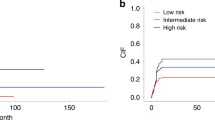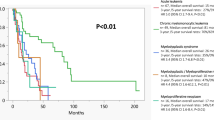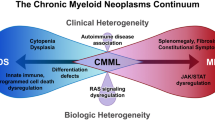Abstract
Hypermetaphase FISH (HMF), a molecular cytogenetic procedure combining the long term mitotic arrest of bone marrow cultures with detection of a specific chromosomal rearrangement by fluorescence in situ hybridization (FISH), has recently been shown to be effective in determining the frequency of Philadelphia chromosome positive (Ph+) cells in the bone marrow of chronic myelogenous leukemia (CML) patients undergoing treatment. By combining the probe for the Ph chromosome with one for the detection of the X chromosome, we used HMF to monitor the presence of malignant cells within the emerging host cell population in the marrow of a CML patient that had undergone sex-mismatched allogeneic bone marrow transplantation. In successive studies, we detected 0.5% and 1.75% Ph+ cells, respectively, confirmed by Western blot analysis for p210 protein. These readings occurred concordantly with a repopulation of host-derived diploid female cells. Standard G-band cytogenetic analyses did not detect any Ph+ cells at these time points. Intervention with donor lymphocyte infusion reinduced complete remission. This experience indicates that HMF is useful to identify low levels of repopulation by Ph+ cells in the marrow post-BMT at a stage when intervention is most efficacious.
This is a preview of subscription content, access via your institution
Access options
Subscribe to this journal
Receive 12 print issues and online access
$259.00 per year
only $21.58 per issue
Buy this article
- Purchase on SpringerLink
- Instant access to full article PDF
Prices may be subject to local taxes which are calculated during checkout
Similar content being viewed by others
Author information
Authors and Affiliations
Rights and permissions
About this article
Cite this article
Seong, D., Giralt, S., Fischer, H. et al. Usefulness of detection of minimal residual disease by ‘hypermetaphase’ fluorescent in situ hybridization after allogeneic BMT for chronic myelogenous leukemia. Bone Marrow Transplant 19, 565–570 (1997). https://doi.org/10.1038/sj.bmt.1700700
Received:
Accepted:
Issue date:
DOI: https://doi.org/10.1038/sj.bmt.1700700
Keywords
This article is cited by
-
Monitoring the course of chronic myelogenous leukemia by fluorescencein Situ hybridization
International Journal of Hematology (2002)
-
Detection and quantification of residual disease in chronic myelogenous leukemia
Leukemia (2000)



